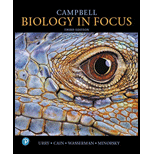
CAMPBELL BIOLOGY IN FOCUS-W/MASTR.BIO.
3rd Edition
ISBN: 9780134875040
Author: Urry
Publisher: PEARSON
expand_more
expand_more
format_list_bulleted
Concept explainers
Question
Chapter 20.5, Problem 2CC
Summary Introduction
To explain:
Why phylogenies based on different genes can yield different branching patterns for the tree of all life.
Introduction:
The evolution history of the organism is known as phylogeny and the branched diagram for evolutionary relationships among species based on their genetic and physical characteristics is known as phylogenetic tree which is also known as evolutionary tree.
Expert Solution & Answer
Want to see the full answer?
Check out a sample textbook solution
Students have asked these similar questions
Explain why phylogenies based on different genes canyield different branching patterns for the tree of all life.
Describe two reasons why it is important to society to study phylogeny and systematics.
Explain what a phylogeny tree and what the nodes on it represent and why it is useful to biologists.
Chapter 20 Solutions
CAMPBELL BIOLOGY IN FOCUS-W/MASTR.BIO.
Ch. 20.1 - Based on the tree in Figure 20.4, are leopards...Ch. 20.1 - Which of the trees shown here depicts an...Ch. 20.1 - Prob. 3CCCh. 20.2 - Decide whether each of the following pairs of...Ch. 20.2 - WHAT IF? Suppose that two species, A and B, have...Ch. 20.3 - Prob. 1CCCh. 20.3 - The most parsimonious tree of evolutionary...Ch. 20.3 - Prob. 3CCCh. 20.4 - What is a molecular clock? What assumption...Ch. 20.4 - MAKE CONNECTIONS Review Concept 14.5. Then...
Ch. 20.4 - WHAT IF? Suppose a molecular clock dates the...Ch. 20.5 - Why is the kingdom Monera no longer considered a...Ch. 20.5 - Prob. 2CCCh. 20.5 - Prob. 3CCCh. 20 - In a comparison of birds and mammals, the...Ch. 20 - To apply parsimony to constructing a phylogenetic...Ch. 20 - Prob. 3TYUCh. 20 - Prob. 4TYUCh. 20 - Prob. 5TYUCh. 20 - If you were using cladistics to build a...Ch. 20 - Prob. 7TYUCh. 20 - SCIENTIFIC INQUIRY DRAW IT (a) Draw a phylogenetic...Ch. 20 - FOCUS ON EVOLUTION Darwin suggested looking at a...Ch. 20 - Prob. 10TYUCh. 20 - SYNTHESIZE YOUR KNOWLEDGE This West Indian manatee...
Knowledge Booster
Learn more about
Need a deep-dive on the concept behind this application? Look no further. Learn more about this topic, biology and related others by exploring similar questions and additional content below.Similar questions
- What is Phylogeny? Explain the importance of Phylogeny ?arrow_forwardPhylogeny refers to the evolutionary descent of taxa. It refers to the relationship between ancestors and descendants and relationships among descendant taxa. It shows the lineage of taxa which can be summarized in a branching diagram called a phylogenetic tree.1. Express some basic evolutionary relationships among groups of microorganisms, plants, and animals; 2. Illustrate the relationship of organisms with their environment; and 3. Analyze environmental factors contributing to biodiversity richness and lossarrow_forwardDraw a phylogenythat accurately portrays the evolutionary relationships among the organisms listed. Each organism listed should be at the tip of a branch on the tree. Use the internet to discover what type of organisms they are, and refer to the textbook and course notes as you determine the relationships among these organisms. Label the phylogeny with each of the 6 species listed and write on the tree where the following derived traits evolved: specialized tissues, radial symmetry, bilateral symmetry, deuterostomy, protostomy, and ecdysozoan cuticle (the need for an animal to molt in order to grow). Anthopleura xanthogrammica Giant Green Anemone Chondrocladia lyra. harp sponge Diadema antillarum black sea urchin Euphasia superba. Antarctic krill Phrynosoma cornutum. horny toad Taenia saginata. beef tapewormarrow_forward
- When reading a phylogenetic tree, which of the following is true regarding the evolutionary relationships among the taxa represented on the tree? Taxa located at adjacent tips of the branches are always more closely related to each other than to other taxa on the tree. Therefore, a species is always equally related to the taxon on the branch immediately to the right it and the taxon on the branch immediately to the left of it The branch lengths always represent the amount of morphological change between taxa The internal nodes (branching points) of the tree represent the most recent common ancestors of the taxa connected by the branches The position of taxa on the tree is completely arbitrary and does not reflect their evolutionary relationshipsarrow_forwardWhat is the difference between morphological phylogeny and molecular phylogeny? What are each of their strength and weakness?arrow_forwardWhat are the ORDER/FAMILYs under Major Cubozoan Taxa? Give their characterictics, distribution, and give 2 example species each order/family.arrow_forward
- explain how genetic information along with an understanding of the process of descent with modification enables scientists to reconstruct phylogenies that extend hundreds of millions of years back in time.arrow_forwardWhat different types of data are used to reconstruct phylogeny? What are the desirable properties of data used to reconstruct phylogeny?arrow_forwardGive typing answer with explanation and conclusionarrow_forward
- Where on the cladogram would you place the common ancestor of brown algae and water molds? The common ancestor of animals and fungi?arrow_forwardWhy do biologists care about phylogenies?arrow_forwardDraw a phylogenetic reconstruction for the hypothetical frog species. Once you have a cladogram you feel confident about, use lines and labels on cladogram to indicate where character states hanged. How many evolutionary changes occurred in your phylogeny? Is there evidence of an evolutionary convergence having occurred in your phylogeny? How about evolutionary reversals?arrow_forward
arrow_back_ios
SEE MORE QUESTIONS
arrow_forward_ios
Recommended textbooks for you
 Concepts of BiologyBiologyISBN:9781938168116Author:Samantha Fowler, Rebecca Roush, James WisePublisher:OpenStax College
Concepts of BiologyBiologyISBN:9781938168116Author:Samantha Fowler, Rebecca Roush, James WisePublisher:OpenStax College

Concepts of Biology
Biology
ISBN:9781938168116
Author:Samantha Fowler, Rebecca Roush, James Wise
Publisher:OpenStax College
Discovering the tree of life | California Academy of Sciences; Author: California Academy of Sciences;https://www.youtube.com/watch?v=AjvLQJ6PIiU;License: Standard Youtube License